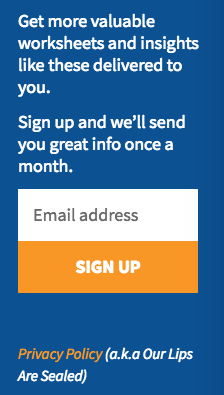Gated content has its advantages and disadvantages, but you shouldn’t be looking at it as an all-or-nothing consideration. Here are some tips on when to gate content, what kinds of content to gate, and how to gate your content effectively.
What is Gated Content
First, let’s define what gated content is. Quite simply, it’s content that requires your site visitor to give in order to get. What they have to give can vary from their email address to actual cash payment. (Though with paid content, you’ll hear the term “behind a pay wall” more often than “gated content.”
Why to Gate Content
The most common reason to gate content as a marketer, is to help move someone a little further along in your funnel. The terms may vary, but essentially you’re pushing them from “site visitor” to “unqualified lead” or something similar.
The other, less productive way to view content gating is as a means to build your email list. Though this is exactly what’s happening when you gate content, viewing the interaction in those terms really doesn’t serve your goals as a marketer. (Unless selling/renting your email list is your revenue source, a rare situation.)
Gating content can work on a deeper level, as well, by being part of a system that allows you to identify your prospects and track their behavior across various interaction points – email, your website, your social media platforms, etc.
This can be valuable in that it allows you to tailor your message to a prospect’s interests, which will increase the value you’re providing them and along with that, the chance that they’ll continue to engage with you.
Why Not to Gate Content
There are times, though, when gating content isn’t the most productive path for us as marketers. These instances generally fall into two categories:
- Lower Value Content
- Brand Marketing
Lower value content isn’t necessarily content with no value; it’s content that your audience can either easily get elsewhere or that simply is so small a nugget of wisdom as to not be worth someone’s email address.
Asking someone for their email address so you can define what an SSL certificate is will not be a reasonable trade. (Though I guess it might be if your goal is attracting the absolutely uninitiated …) An 8-page guide to choosing the right SSL certificate and properly installing it is certainly worth a prospect’s email.
In the case of brand marketing, your goal isn’t as direct as it might otherwise be. In other words, you’re not necessarily trying to capture leads but to establish thought leadership, demonstrate domain expertise, or build brand awareness.
In those case – as with this blog post – the goal is to reach as wide an audience as possible, and gating will only decrease the size of your audience.
Effective Content Gating
Once you’ve decided to gate, how you choose to do it will have an impact on how effective your content is. As a general rule, you’ll want to ask for as little information as you can. The more fields in your gating form, the fewer people you’ll entice.
So for basic introductory content and content that is meant to appeal to prospects early in their buying process, ask for an email address and only an email address.

For content aimed at folks deeper in the buying process, you can ask for more information. You can also ask for a lot of information if the content you’re providing is going to be tailored to their needs based on the information you’re asking for.
You can also tailor your forms using progressive profiling so that the form varies depending on who is viewing it. This allows you to ask for more information without increasing the number of fields on the form. That is, the form might request just an email address the first time around. The next visit, the form is for a different piece of content and, recognizing the prospect might ask for the email address (as a confirmation) and company name.
After that, the form would still have just two fields, but might ask for the person’s title or the company size or whatever other data points help you tailor your marketing to your different audience segments.
So for most content marketers, the question isn’t whether you should or shouldn’t gate your content, but which content should be gated and how should you be gating it.